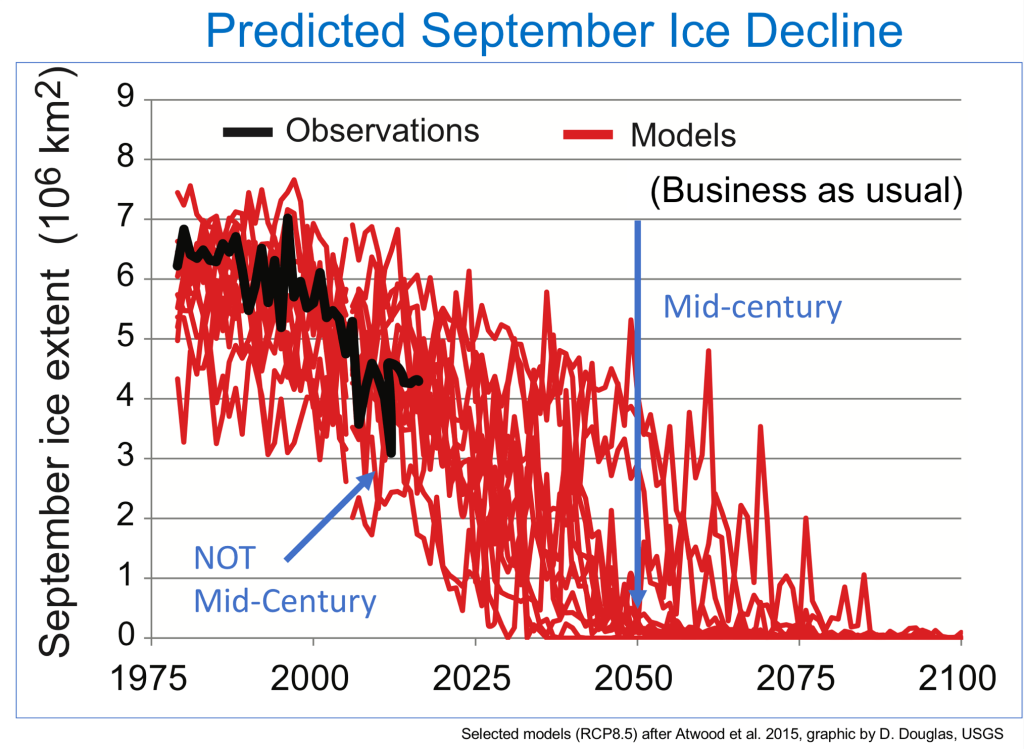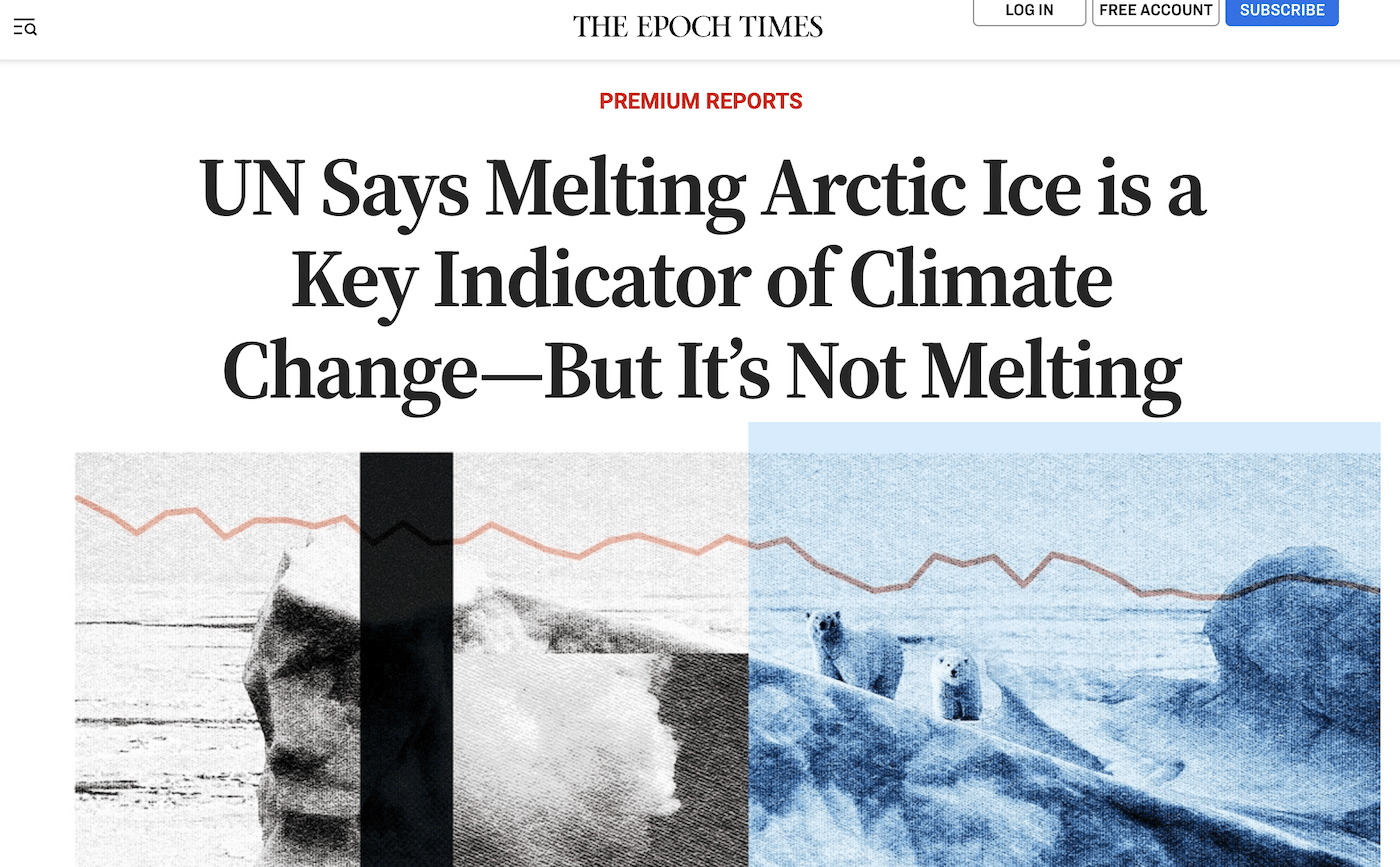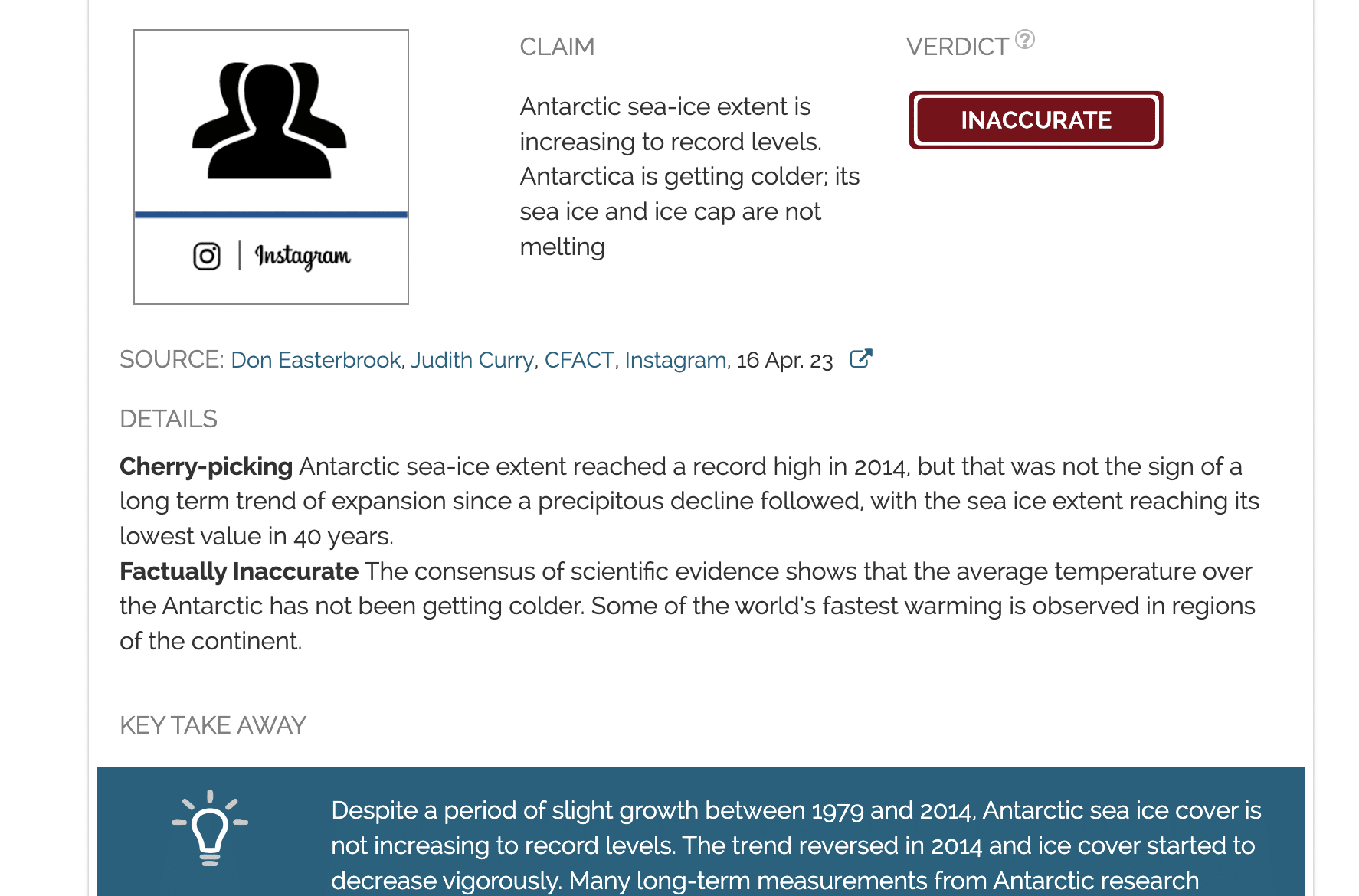- Climate
Financial Post publishes misleading opinion that misrepresents science of polar bears’ plight
Reviewed content
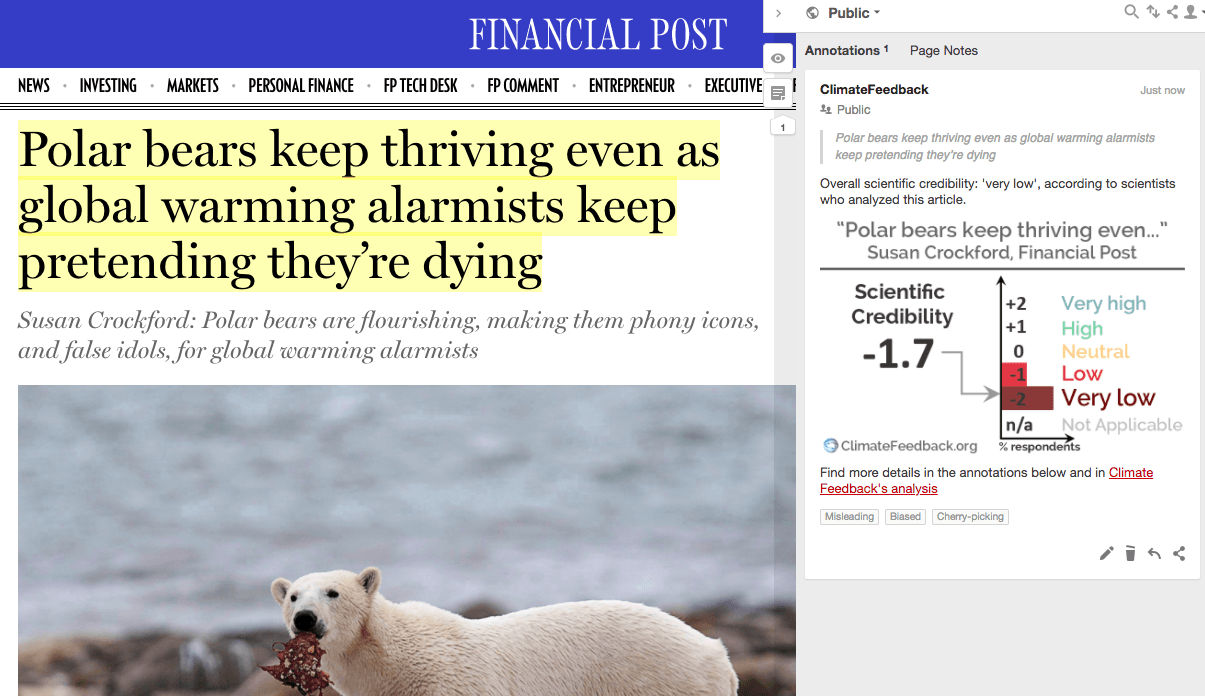
Headline: "Polar bears keep thriving even as global warming alarmists keep pretending they’re dying"
Published in Financial Post, by Susan Crockford, on 2018-02-27.
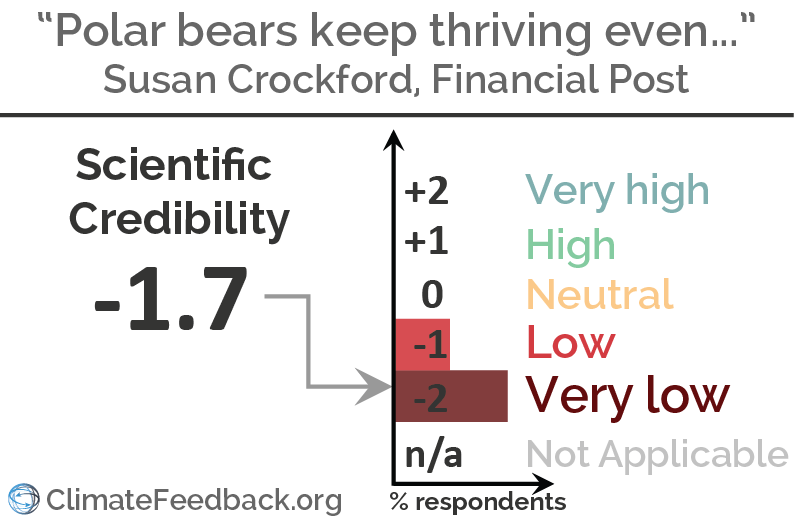
Scientists’ Feedback
SUMMARY
This article in the opinion section of Financial Post, written by Susan Crockford, claims that rather than being threatened by declining Arctic sea ice, polar bears are “thriving”.
Three scientists who reviewed the article explained that this article fundamentally misrepresents research on the topic. The author exhibits poor reasoning in arguing that polar bear population loss projected for 2050 should have occurred already if that science was accurate. Researchers do not ignore the evidence Crockford claims they do, but instead incorporate all published research on polar bear populations. Despite the article’s statements to the contrary, research shows that polar bear populations will struggle as ice-free periods (during which they cannot hunt for food) grow longer.
REVIEWERS’ OVERALL FEEDBACK
These comments are the overall opinion of scientists on the article, they are substantiated by their knowledge in the field and by the content of the analysis in the annotations on the article.
Andrew Derocher, Professor, University of Alberta:
The article is nonsense and reflects a profound lack of understanding of polar bear ecology, ringed seal ecology, Arctic marine ecosystem, and sea ice.
Cody Dey, Postdoctoral Fellow, University of Windsor:
The article cherry picks scientific results and does not consider the total weight of scientific evidence which clearly indicate that polar bears are negatively affected by sea ice loss.

Chief Scientist, Polar Bears International, and Adjunct Professor University of Wyoming in Laramie
The article is composed of misstatements. These are either based upon the author’s apparent lack of understanding of the ecological and geophysical situations, or intent to mislead readers.
Notes:
[1] See the rating guidelines used for article evaluations.
[2] Each evaluation is independent. Scientists’ comments are all published at the same time.
Annotations
The statements quoted below are from the article; comments and replies are from the reviewers.
“Although the extent of the summer sea ice after 2006 dropped abruptly to levels not expected until 2050, the predicted 67-per-cent decline in polar bear numbers simply didn’t happen. Rather, global polar bear numbers have been stable or slightly improved.”

Chief Scientist, Polar Bears International, and Adjunct Professor University of Wyoming in Laramie
This blogger has repeatedly criticized polar bear projections because what we predicted for mid-century has not yet happened. Most of the climate model projections for sea ice decline show summer ice down to near zero by mid century and they all converge on zero by the end of the century. None of the mainstream models of which I am aware project that summer ice would be gone by now. Of course summer ice availability has been reduced from earlier years, but neither observations nor models suggest that what we predicted for mid century has already happened. Here is an image that may help put this in perspective, and make it clear why our projections focused on mid century and beyond, and that we are not yet in mid-century:
Andrew Derocher, Professor, University of Alberta:
This is nonsense. No polar bear scientist has predicted a drop in polar bear abundance based on summer sea ice. We base the assessment of loss on duration of the ice-free period. Papers1,2 from our research group assess this point. The statement about global polar bear numbers is absolutely unfounded. It is a contrived statement using population estimates provided so that children (or the general public) could give a number of polar bears in the world for school reports and the like.
Castro de la Guarida1 states, “Sea ice across the Arctic is declining and altering physical characteristics of marine ecosystems. Polar bears (Ursus maritimus) have been identified as vulnerable to changes in sea ice conditions. We use sea ice projections for the Canadian Arctic Archipelago from 2006 – 2100 to gain insight into the conservation challenges for polar bears with respect to habitat loss using metrics developed from polar bear energetics modeling. PRINCIPAL FINDINGS: Shifts away from multiyear ice to annual ice cover throughout the region, as well as lengthening ice-free periods, may become critical for polar bears before the end of the 21st century with projected warming. Each polar bear population in the Archipelago may undergo 2-5 months of ice-free conditions, where no such conditions exist presently. We identify spatially and temporally explicit ice-free periods that extend beyond what polar bears require for nutritional and reproductive demands. CONCLUSIONS/SIGNIFICANCE: Under business-as-usual climate projections, polar bears may face starvation and reproductive failure across the entire Archipelago by the year 2100.”
Both of these studies1,2 assess the threat to polar bears based on projected sea ice loss over the next 3 generations (ca. 33-45 years). It is an issue of fasting duration that causes polar bear population declines and this is well understood in the published literature.
Dr. Crockford is following the standard climate change denier approach of picking on a specific detail and then contriving an unsubstantiated fictional account on that point. Loss of sea ice in summer is, by and large, irrelevant. It’s the duration of the ice-free period that matters. If not, polar bears in Hudson Bay would have disappeared hundreds or thousands of years ago but they didn’t because they used to be able to obtain sufficient fat stores while hunting seals on the sea ice in spring. The situation is changing but the best estimate is that we’ll have significant declines in the Western Hudson Bay population (beyond the current ca. 30% decline) by mid-century. By repeating it often enough, it appears that deniers or the uninformed think there’s some merit to the issue Dr. Crockford has raised. Nobody can scientifically rebut the flawed thesis because it isn’t published. My understanding was that the manuscript was rejected by scientific journals so now Dr. Crockford’s manuscript languishes as an unreviewed “Preprint” in PeerJ and she erroneously calls it a “paper”.
- 1- Castro de la Guardia et al (2013) Future sea ice conditions in western Hudson Bay and consequences for polar bears in the 21st century, Global Change Biology
- 2- Regehr et al (2016) Conservation status of polar bears (Ursus maritimus) in relation to projected sea-ice declines, Biology Letters
“For example, Canadian polar bear biologist Ian Stirling learned in the 1970s that spring sea ice in the southern Beaufort Sea periodically gets so thick that seals depart, depriving local polar bears of their prey and causing their numbers to plummet. But that fact, documented in more than a dozen scientific papers, is not discussed today as part of polar bear ecology.”

Chief Scientist, Polar Bears International, and Adjunct Professor University of Wyoming in Laramie
Both Ian Stirling and I have published on the inter-annual and even multi-annual variation in sea ice extent, etc. There is a great deal of annual variation among years, as always. And as the observations and models illustrate, the variation (caused by the natural chaos in the climate system) that always has been observed will continue into the future. Ian specifically mentioned in some early publications that there seemed a nearly decadal oscillation in ice thickness, etc.
Ideal habitat for polar bears and ice loving seals (like all animals) follows a kind of bell-shaped curve. Ice can be too thick and heavy, just right, or too thin (which also means it doesn’t persist long during the melt season). Most of those early years there was plenty of ice that persisted through the summer in the Beaufort Sea. Even most light ice years had enough ice there to not be a problem. Some years (and seemingly on about 10 year intervals) were characterized by ice that was apparently too heavy to be ideal for seals and bears, and in those years productivity of both declined. It is important to point out that the concept of an approximate 10-year oscillation was based on 3 decades (70s, 80s, and 90s) and a sample size of 3 may not really be enough to establish some kind of natural cycle.
Regardless, as the world has warmed and ice continued to thin, evidence of any such cycle in the Alaskan Beaufort has disappeared. We did not see a crush of heavier ice in the middle of the first or second decades of the 2000s. Rather, the situation now is that ice is thin every year and has not persisted through the melt season in the critical continental shelf waters. Why would researchers spend much time now discussing a pattern in the sea ice that no longer rises to historic levels? Whether they are part of a larger scale oscillation or more regional weather patterns, year to year and multi-year differences in the amount of sea ice and its character are part of the natural variation in the climate system that will continue as the world warms due to human activity.
Global warming doesn’t mean that every year will be a bit warmer than the previous or that the sea ice extent will be a bit lower. Rather it means that the average of the natural variations over multiple years is and will continue to be warmer temperatures and less sea ice. Without persistent greenhouse gas rise, the historic averages of natural variations in global temperature and Arctic sea ice extent were approximately horizontal baselines—both temperature and sea ice extent were without major trend when examined over decades. With persistently rising greenhouse gas levels all of the natural variation still occurs, but now occurs over inclined rather than level baselines.
With greenhouse gas levels constantly rising, there still are near-term fluctuations in annual and seasonal temperatures. Some years warmer and some cooler than the one before, but the average over decades is a rising trend line. Likewise, some years have had and will have more summer ice than the previous year, and some less. Whether those short term variations in Arctic sea ice extent are due to annual weather influences or multi-year cycles driven by broader oceanic patterns, they are now and will continue to be occurring over a declining baseline as long as greenhouse gas levels continue to rise. Hence, it is not the swings in individual years or groups of years, but rather the trend line that is our concern. And as long as greenhouse gas concentrations continue to rise, average temperatures can only increase and average sea ice extent can only decline.
The average Arctic summer sea ice extent already is so far below the historic levels that recent short term fluctuations have not overlapped with levels of just a few decades ago. Hence, what might have been called relatively “heavier” ice years are now light years by historic standards.
Andrew Derocher, Professor, University of Alberta:
Sea ice conditions are well document to be in steep decline in the southern Beaufort Sea. This polar bear population has declined 25-50% and the loss is related to sea ice loss. There are many papers that address this issue extensively. Heavy sea ice conditions are largely a past issue for ringed seals. It is loss of sea ice habitat as a whole that is negatively affecting ringed seals and thus polar bears. Polar bears have a Goldilocks relationship with sea ice: not too much, not too little, it has to be just right. Dr. Crockford is playing the “too much” sea ice issue to its extreme and ignores the too little aspect altogether.
These two papers1,2 are core but there are many more addressing sea ice loss in the Beaufort and the effects on polar bears.
- 1- Bromaghin et al (2015) Polar bear population dynamics in the southern Beaufort Sea during a period of sea ice decline, Ecological Applications
- 2- Hunter et al (2010) Climate change threatens polar bear populations: a stochastic demographic analysis, Ecology
“many scientists were surprised when other researchers subsequently found that ringed and bearded seals (the primary prey of polar bears) north of the Bering Strait especially thrived with a longer open-water season, which is particularly conducive to fishing”

Chief Scientist, Polar Bears International, and Adjunct Professor University of Wyoming in Laramie
The Chukchi sea is essentially all continental shelf and is probably the most productive of the Arctic Seas. This is in contrast to the Beaufort Sea which, beyond the very narrow continental shelf, is very unproductive. Recent research has shown that this tremendous productivity and the fact that, although ice has significantly retreated, bears there still have fewer ice free days over the shelf than in the Beaufort, can explain why Chukchi Sea polar bears have not yet declined like those in the Beaufort.
Andrew Derocher, Professor, University of Alberta:
Both ringed seals and bearded seals are sea ice obligate species: there are significant conservation concerns about both species across the Arctic. The basis of the statement that the seals are thriving is unfounded in the peer-reviewed literature. Both species are listed under the US Endangered Species Act.
The polar bears living north of the Bering Strait have not shown the same loss in body condition, survival, and reproduction noted in the neighboring Beaufort Sea because the ecosystems are vastly different in the distribution of continental shelf habitat: huge area in the Chukchi Sea, a narrow band in the Beaufort. Polar bear populations respond to local changes, and with 19 polar bear populations, there will be 19 different scenarios playing out over time. Loss of sea ice in the Chukchi Sea in winter 2017/18 may change the situation there.
“while it’s true that studies in some regions show polar bears are lighter in weight than they were in the 1980s, there is no evidence that more individuals are starving to death or becoming too thin to reproduce because of less summer ice.”

Chief Scientist, Polar Bears International, and Adjunct Professor University of Wyoming in Laramie
We know that polar bears depend on the ice surface to catch their prey. We know that increasing numbers of ice free days have resulted in poorer body condition in some areas (e.g. Southern Beaufort, Western and Southern Hudson Bay), we know that poorer cub survival has followed both declining ice and poorer body condition, and all the evidence suggests these things are linked. Perhaps this is not “proof” that less available summer ice is the cause (correlation does not necessarily imply causation), but I am not aware of evidence for any other explanation. And I don’t think the female polar bears are intentionally having cubs but not feeding them.
Andrew Derocher, Professor, University of Alberta:
There is evidence. Bromaghin et al 20151 and Hunter et al 20102 examine this issue.
Bromaghin et al state, “Low survival from 2004 through 2006 led to a 25–50% decline in abundance. We hypothesize that low survival during this period resulted from (1) unfavorable ice conditions that limited access to prey during multiple seasons; and possibly, (2) low prey abundance. For reasons that are not clear, survival of adults and cubs began to improve in 2007 and abundance was comparatively stable from 2008 to 2010, with ~900 bears in 2010 (90% CI 606–1212). However, survival of subadult bears declined throughout the entire period. Reduced spatial and temporal availability of sea ice is expected to increasingly force population dynamics of polar bears as the climate continues to warm. However, in the short term, our findings suggest that factors other than sea ice can influence survival.”
Hunter et al stated, “Deterministic models projected population growth in years with more extensive ice coverage (2001-2003) and population decline in years with less ice coverage (2004-2005). LTRE (life table response experiment) analysis showed that the reduction in lambda in years with low sea ice was due primarily to reduced adult female survival, and secondarily to reduced breeding. A stochastic model with two environmental states, good and poor sea ice conditions, projected a declining stochastic growth rate, log lambda(s), as the frequency of poor ice years increased. The observed frequency of poor ice years since 1979 would imply log lambda(s) approximate to -0.01, which agrees with available (albeit crude) observations of population size. The stochastic model was linked to a set of 10 GCMs compiled by the IPCC; the models were chosen for their ability to reproduce historical observations of sea ice and were forced with “business as usual” (A1B) greenhouse gas emissions. The resulting stochastic population projections showed drastic declines in the polar bear population by the end of the 21st century. These projections were instrumental in the decision to list the polar bear as a threatened species under the U. S. Endangered Species Act.”
- 1- Bromaghin et al (2015) Polar bear population dynamics in the southern Beaufort Sea during a period of sea ice decline, Ecological Applications
- 2- Hunter et al (2010) Climate change threatens polar bear populations: a stochastic demographic analysis, Ecology
“The failure of the 2007 polar bear survival model is a simple fact that explodes the myth that polar bears are on their way to extinction.”

Chief Scientist, Polar Bears International, and Adjunct Professor University of Wyoming in Laramie
Multiple papers published subsequent to my work in 2007 have corroborated the outcomes we projected. However, the accuracy or failure of my work to inform the Secretary of Interior* cannot be evaluated until mid century. And as the figure above shows, we are not there yet.
- Amstrup et al (2010) Greenhouse gas mitigation can reduce sea-ice loss and increase polar bear persistence, Nature

